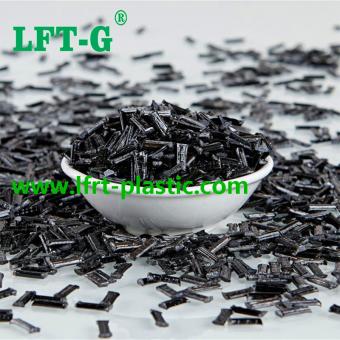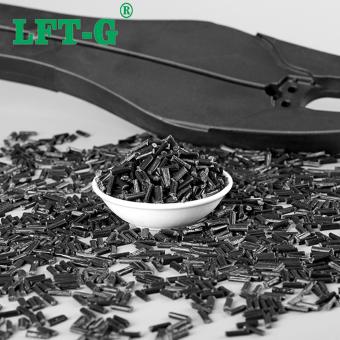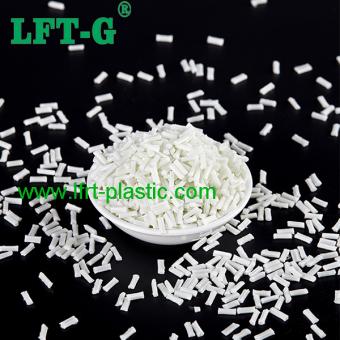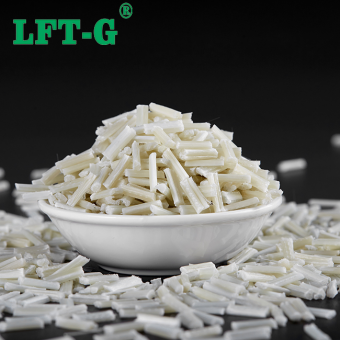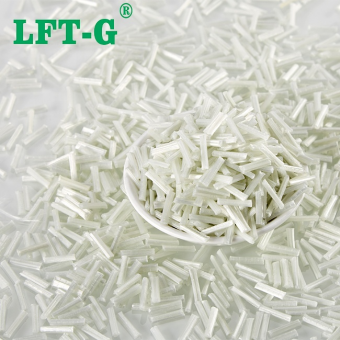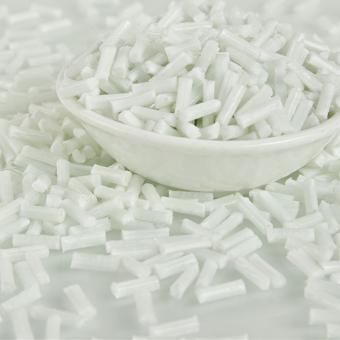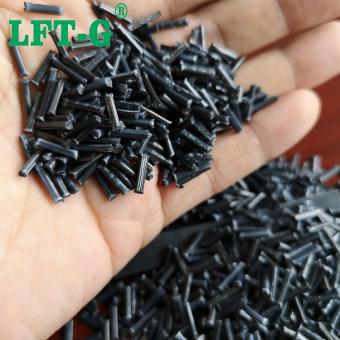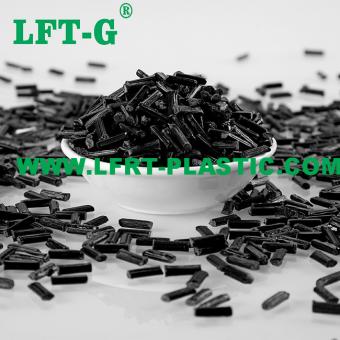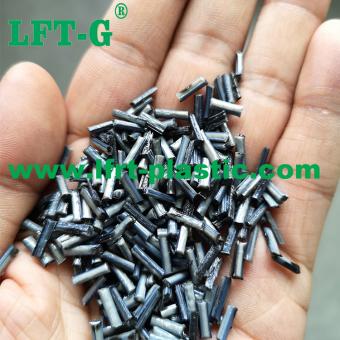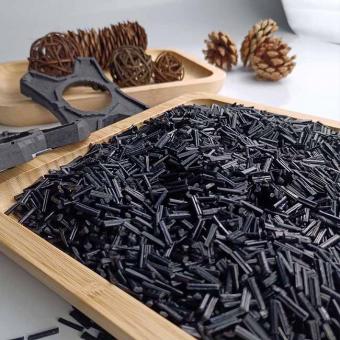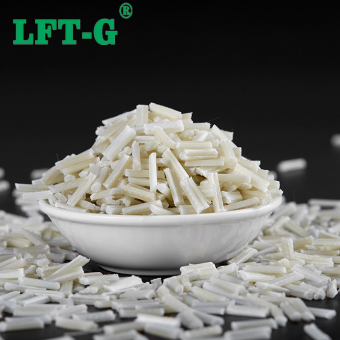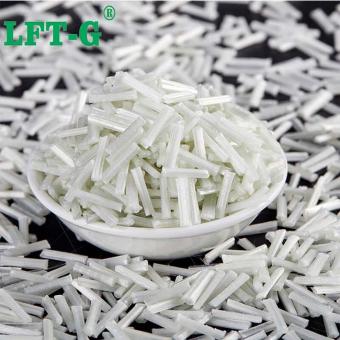-
PA66 Polyamide66 natural black filled lcf long carbon fiber made in China high qualityPA66 Nylon (PA) has a series of excellent properties, such as high mechanical strength, chemical resistance, oil resistance, wear resistance, self-lubrication, easy processing and forming, and has become one of the thermoplastic engineering plastics widely used at home and abroad. But in the practical application, the performance requirements of nylon are different under different conditions or environment. For example, electric drill and motor shell, pump impeller, bearing, diesel engine and air conditioning fan and other parts require nylon material to have high strength, high rigidity and high dimensional stability; Because of the poor toughness of nylon at low temperature, it is necessary to toughen it. In some outdoor applications, nylon materials must be weather-resistant modification in long-term outdoor environment. PA66-LCF Long carbon fiber reinforced nylon has excellent damping properties in 3D printing and has better performance than glass fiber reinforced nylon. In the design of tools for industrial applications, traditional techniques have used aluminum or alternative metal alloys because metal components perform better and meet the requirements of the tool. In many cases, thermoplastics can meet the strength requirements of such tools, but not the rigidity requirements for performing test tasks. Carbon fiber reinforced nylon is an ideal substitute for metal. Due to the combination of the light weight of nylon and the mechanical strength and thermal properties of carbon fiber, the strength and stiffness of carbon fiber composite nylon material is significantly improved, and its mechanical strength even exceeds that of 3D-printed PEEK and PEKK. In the automobile industry, from internal and external components such as vehicle anchors and instruments to engine housing, metal parts can be replaced. As we all know, automotive carbon fiber is widely used in automobile manufacturing due to its strong thermal and mechanical properties. As a substitute for metal parts, carbon fiber reinforced nylon has a wide range of application prospects in the automobile industry, which can realize the possibility of weight reduction and design optimization, as well as environmental protection and economic advantages. TDS Application Package Patents
- PA66 composite fiber
- PA66 resin compound
- LFT-G brand plastic
- PA66 LCF carbon
- new plastic material fiber
- High performance lcf
Tags :
-
LFT-G PA66 with filler long carbon fiber 40% specification reinforced plastic high toughness sample availablePolyamide 66 Nylon is the common name for polyamide (PA), a generic term for thermoplastic resins containing repeating amide groups on the main chain of the molecule, including aliphatic polyamides, aliphatic-aromatic polyamides and aromatic polyamides. As one of the top five engineering plastics, nylon has an extremely wide range of industrial applications, mainly in automotive parts, mechanical parts, electronics and appliances, cosmetics, adhesives and packaging materials. Among them, the largest production and most widely used are aliphatic polyamides, mainly nylon 66 and nylon 6. Nylon 66 (PA66) is made by condensation of adipic acid and hexanediamine, which is a class of polyamide. Advantages: high strength, corrosion resistance, good wear resistance characteristics, and has self-lubricating, flame retardant, non-toxic environmental protection and other excellent performance. Disadvantages: poor heat resistance and acid resistance, low impact strength in dry state and low temperature, high water absorption affects the dimensional stability and electrical properties of products. Polyamide 66 filling long carbon fiber High-performance fibers are chemical fibers with high load-bearing capacity and high durability because they have a special physical or chemical structure embodied with some excellent characteristics that traditional fibers do not have, such as high temperature resistance, corrosion resistance, flame retardancy and other properties. Carbon fiber is an inorganic polymer material with carbon content higher than 90% obtained from organic fibers through carbonization and graphitization. Advantages: light weight, high strength, high modulus, high temperature resistance, wear resistance, corrosion resistance, fatigue resistance, electrical conductivity, thermal conductivity, etc. Disadvantages: high cost, relatively difficult to infiltrate, poor transparency, etc. Carbon fiber composite materials are very useful structural materials, which are not only light, high temperature resistant, but also have high tensile strength and elastic modulus, and are indispensable materials for the manufacture of spacecraft, rockets, missiles, high-speed aircraft and large passenger aircraft. In transportation, chemical industry, metallurgy, construction and other industrial sectors, as well as sports equipment and other aspects have a wide range of applications. The density of PA66/CF composites tends to increase slightly as the content of CF increases. This is due to the fact that the density of CF is larger compared to that of PA66. The fracture surface of PA66 is smoother, while the fracture surface of PA66/CF sample is extremely rough and CF is pulled out, which indicates that the CF in the system plays a good role in bearing the load when the composite sample is subjected to external force, and this fracture is a ductile fracture, therefore, PA66/CF composite is a ductile material. With the increase of CF content, the tensile strength of PA66/CF composites increased significantly. The flexural strength and flexural modulus of PA66/CF composites are increased substantially with the increase of CF content. Datasheet for reference We can provide PA66 filiing Long carbon fiber 20%-60%. If you need more datas, please contact us. Application Our products are mainly suitable for large products such as structural parts and load-bearing parts, and the above applications are for reference only. If you have other products, please feel free to consult our technical experts to provide you with 1-to-1 service. Laboratory & Warehouse Teams & Customers Welcome to contact us for more informations!
- Polyamide66 reinforced plastic cf
- long carbon fiber filling nylon66
- thermoplastic resin pa66 cfrp
- injection mold pa66-lcf compounds
- composite long carbon fiber PA66 black
- high performance pa66 carbon fiber modified
Tags :
-
LFT-G Polyamide 12 nylon plastic resin thermoplastic filling long glass fiber injection mold high strengthWhat is long chain nylon? It is a nylon with amide group in the main chain repeating unit of nylon molecule, the length of methylene group between two amide groups is more than 10. we call it long carbon chain nylon, including nylon 11, nylon 12, etc. It not only has most general properties of general nylon, such as lubricity, wear resistance, compression resistance, easy processing, but also has good toughness and flexibility, low water absorption, good dimensional stability, excellent of dielectric properties, good wear resistance and low density. Among the long-chain nylons, PA12 has the lowest water absorption, lowest density, low melting point, impact resistance, friction resistance, low temperature resistance, fuel resistance, good dimensional stability and good anti-noise effect compared with other nylon materials.PA12 has the properties of PA6, PA66 and polyolefin (PE, PP) at the same time. Due to the long methylene chain of PA11 and PA12 and the low density of amide in the molecular chain, PA11 and PA12 have similar performance. Compared with PA12, the disadvantage of PA11 is the low yield of ricinoleic acid and the expensive price, which limits the large-scale promotion of PA11. Polyamide 12 filling long glass fiber Glass fiber is an inorganic non-metallic material with excellent performance, is a natural mineral with silica as the main raw material, add specific metal oxide mineral raw materials, mixed uniformly, molten at high temperature, molten glass liquid flow through the funnel outflow, in the role of high-speed pull gravitational force is drawn and rapidly cooled and cured into a very fine continuous fiber. Glass fiber monofilament diameter from a few microns to more than twenty microns, equivalent to a hair of 1/20-1/5, each bundle of fiber original filament are composed of hundreds or even thousands of monofilaments. Glass fiber has high tensile strength, high elasticity coefficient, excellent characteristics such as non-combustibility, chemical resistance, low water absorption, and good processing performance, etc. It is usually used as a reinforcing material in composite materials and is widely used in various fields. Long Glass Fiber LFT Features and Benefits -After glass fiber reinforcement, glass fiber is a high temperature resistant material, therefore, the heat resistance temperature of reinforced plastics is much higher than before without glass fiber, especially nylon plastics. -After glass fiber reinforcement, the addition of glass fiber restricts the movement of polymer chains between plastics, therefore, the shrinkage of reinforced plastics decreases a lot and the rigidity is also greatly improved. -After glass fiber reinforcement, the reinforced plastic will not be stress cracked, and the impact resistance of the plastic will be improved. -After glass fiber reinforcement, glass fiber is a high-strength material, which also greatly improves the strength of plastic, such as: tensile strength, compression strength, bending strength, much higher. -After the glass fiber reinforcement, the burning performance of the reinforced plastic decreases a lot due to the addition of glass fiber and other additives, and most of the materials cannot be ignited, which is a kind of flame retardant material. Application PA12-NA-LGF is suitable for scooter parts/auto parts/Tire parts/Firearms parts, and etc. Datasheet for reference Certifications Xiamen LFT composite plasctic CO., Ltd. The rapid development of technology has led to the emergence of LFT carbon fiber composites. Long Fiber (Xiamen) New Material Technology Co., Ltd, provides professional customization service for modified reinforced long carbon fiber composites. Xiamen LFT composite plastic Co., Ltd. was founded by a veteran of the thermoplastic reinforced composite industry, focusing on the development and production of (LFT-G.LFRT,LFT) long glass/carbon fiber reinforced thermoplastic engineering plastics. The company produces long carbon fiber composites with the advantages of light weight, high strength, high impact thermal resistance, design and recycleable, green and environmental protection. Compared with traditional materials, it requires lower cost, better corrosion and chemical resistance, and better molding and processing performance, making it the golden material of the 21st century. Long Fiber (Xiamen) New Material Technology Co: Ltd. is engaged in the development and production of LFRT series of long glass fiber (LGF) and long carbon fiber (LCF) PP, PA6, PA66, PPA, PA12, TPU, PBT, PLA, PET, PPS, PEEK and other engineering plastics. Series of products can be used in the manufacture of home appliances, aerospace, automotive, military, electrical and other parts, such as gears, rollers, pulleys, drums, pump impellers, fan blades, etc. They can also be used in the manufacture of medical equipment, sporting goods, daily necessities and other fields.
- PA12 LGF polymers 30
- Long glass fiber reinforced polyamide 12
- nylon resin filled gf high performance
- Lightweight PA12-LGF instead metal
- LFT-G PA12 GF
- PA12 modified plastic
Tags :
-
LFT-G brand high strength PBT reinforced plastic Long Glass Fiber filled injection grade compounds best pricePBT materials Polybutylene terephthalate (PBT) is a thermoplastic polyester and one of the top five engineering plastics. PBT has excellent overall performance, is one of the toughest engineering plastics, and has high dimensional stability, good chemical resistance, excellent electrical insulation, good mechanical properties and elasticity, low water absorption, etc. PBT filling Long glass fiber compounds PBT (polybutylene terephthalate) is a polyester-based plastic, while glass fiber is a reinforcing material that is usually added to plastics in fiber form to enhance their mechanical properties. When PBT is combined with glass fibers, the following effects occur: 1. Enhanced strength and stiffness: glass fiber has excellent strength and stiffness, and adding it to PBT can significantly increase the mechanical properties of the plastic. This makes the material of PBT with glass fiber more strong and rigid when it is subjected to force or stress, and less likely to deform or break. 2. Improve heat resistance: glass fiber has a high melting point and good heat resistance performance. When glass fiber is added to PBT, it can improve the heat resistance of PBT, so that it can keep better performance at higher temperature and prevent softening or melting. 3. Improve corrosion resistance: Glass fiber has excellent corrosion resistance, and adding it to PBT can improve its resistance to chemicals, solvents and other corrosive media. This makes PBT with glass fiber have longer service life in some special environments. 4. Improve insulation performance: PBT itself has good insulation performance, and the addition of glass fiber further improves the insulation performance of PBT material. This makes the PBT with glass fiber more suitable for electrical and electronic applications, which can effectively isolate the current and reduce leakage and electromagnetic interference. All in all, PBT with glass fiber can enhance the mechanical properties, heat resistance, corrosion resistance and insulation properties of plastics, making them more widely used in various applications. However, the performance of the material may vary depending on the specific glass fiber content and the addition process. Fiber specification Grade Fiber specification Characteristics Application Length Color Package General grade 20%-60% High toughness, Low warpage Electronic appliances, mechanical parts, etc. About 12mm, or customzied Natural color, or customized 25kg/bag The difference between LGF & SGF Short glass fiber particles: Size size is about 3-4mm, length to width ratio 50-250 Long glass fiber particles: Size is about 10-12mm, aspect ratio >400 In addition, the distribution of glass fiber in the two kinds of particles is also different. Compared with SGF, the rigidity, strength and modulus of LGF have been improved, especially the notched impact performance has got a qualitative leap. Application Datasheet for reference About us Xiamen LFT composite plastic Co., Ltd. is a brand-name company that focuses on LFT&LFRT. Long Glass Fiber Series (LGF) & Long Carbon Fiber Series (LCF). The company's thermoplastic LFT can be used for LFT-G injection molding and extrusion, and can also be used for LFT-D molding. It can be produced according to customer requirements: 5~25mm length. The company's long-fiber continuous infiltration reinforced thermoplastics have passed ISO9001&16949 system certification, and the products have obtained lots of national trademarks and patents.
- PBT reisn composite lgf 30
- long glass fiber reinforced pbt for auto parts
- virgin white pbt can be recycled lgf
- thermoplastic plastic pbt lft
- high performance pbt with filler lgf
- PBT composite plastic
Tags :
-
LFT-G TPU reinforced plastic filling long glass fiber pellets polymers high strength made by own factory customized plasticWhat is TPU plastic? TPU (Thermoplastic polyurethanes) name for thermoplastic polyurethane elastomer rubber, TPU is by diphenylmethane diisocyanate (MDI) or toluene diisocyanate (TDI) and other diisocyanate molecules and macromolecules of polyols, low molecular polyols (chain expander) common reaction polymerization between rubber and plastic of a class of polymer materials. It is a kind of polymer material between rubber and plastic. It has the softness of rubber and the hardness of hard plastic. It has strong high tension and tensile force, is a mature environmentally friendly material, and has been certified by the international green material related certification. This material can be softened under a certain degree of heat, but can remain unchanged at room temperature. It is used in many kinds of products to stabilize and support. What is Long glass fiber compounds? 1.Definition of long fiber glass reinforced thermoplastics Long fibrereinforced thermoplastics (Long fibrereinforced thermoplastics), abbreviated as LFT, refers to the length of more than 5mm glass fiber reinforced composite materials (LFT), has good molding and processing properties, can be molded through injection molding, extrusion and other processes, molding plastic molding fluidity is good, can be under low pressure, can mold complex shapes, the apparent quality of the products is also better than GMT, at the same time, the cost of LFT than GMT greater advantage. LFT has good molding performance, can be molded by injection molding, extrusion and other processes, good molding fluidity, can be molded under low pressure, can be molded in the shape of complex products, the apparent quality of the product is also better than GMT, at the same time, the cost of LFT has a greater advantage than GMT. LFT is used in the largest number of base resins is PP, by PA, but also the use of PBT, PPS, TPU and other resins. It is worth mentioning that for different resins need to use different fibers to achieve better results. 2. Advantages of long glass fiber reinforced plastics (compared to short glass fiber reinforced plastics) High rigidity at higher temperatures High toughness at high and low temperatures Less shrinkage and less warpage Low creep Good chemical resistance Linear coefficient of thermal expansion close to that of metals Low overall system cost Datasheet for reference Product details Grade Fiber specification Main characteristics Application General grade 30%-60% High toughness, high rigidity, low water absorption, high dimensional stability, chemical resistance, and good product appearance. Automobile frames, safety shoe toes, machinery parts, air nail gun stocks, specialized electrician's tools, nuts and bolts, etc. Produce processing Tests Heat Deflection Temperature Testing Vicat Softening Temperature Testing Tensile & Flexural Strength & Elongation Testing Density & Melt Flow Rate Testing Impact Strength Testing and etc. About us Xiamen LFT composite plastic Co., Ltd. is a brand-name company that focuses on LFT&LFRT. Long Glass Fiber Series (LGF) & Long Carbon Fiber Series (LCF). The company's thermoplastic LFT can be used for LFT-G injection molding and extrusion, and can also be used for LFT-D molding. It can be produced according to customer requirements: 5~25mm length. The company's long-fiber continuous infiltration reinforced thermoplastics have passed ISO9001&16949 system certification, and the products have obtained lots of national trademarks and patents.
- Long glass fiber filled tpu plastic
- Thermoplastic polyurethanes modified plastic
- injection molded tpu for shoes
- lgf tpu high performance
- tpu basic resin for engineering use
- long fibre reinforced thermoplastics
Tags :
-
LFT-G HDPE raw materials filling LGF 30%-60% high toughness compunds pellets 12mm length sample freeHDPE High density polyethylene (HDPE), a granular product. Non-toxic, odorless, crystallinity of 80% ~ 90%, softening point of 125 ~ 135 ℃, the use of temperature up to 100 ℃; hardness, tensile strength and creep is better than low-density polyethylene; wear resistance, electrical insulation, toughness and cold resistance is better; good chemical stability, at room temperature, insoluble in any organic solvents, resistant to corrosion of acids, alkalis and various salts. Long glass fiber Glass fiber reinforced plastic is based on the original pure plastic, adding glass fibers and other additives, so as to improve the scope of use of the material. Generally speaking, most of the glass fiber reinforced materials are used in the structural parts of the products, which is a kind of structural engineering materials, such as: PP, ABS, PA66, PA6, HDPE, PPA, TPU, PEEK, PBT, PPS and so on. Advantages After glass fiber reinforcement, glass fiber is a high temperature resistant material, therefore, the heat-resistant temperature of reinforced plastics is much higher than before without glass fiber, especially nylon plastics. After the glass fiber reinforcement, due to the addition of glass fiber, the plastic polymer chain is restricted to move with each other, therefore, the shrinkage of reinforced plastics decreases a lot, and the rigidity is greatly improved. After glass fiber reinforced, the reinforced plastic will not stress cracking, at the same time, the impact resistance of the plastic improves a lot. After the glass fiber reinforcement, the glass fiber is a high strength material, which also greatly improves the strength of the plastic, such as: tensile strength, compression strength, bending strength, improve a lot. After glass fiber reinforcement, due to the addition of glass fiber and other additives, the combustion performance of the reinforced plastics decreases a lot, most of the materials can not be ignited, it is a kind of flame-retardant material. Datasheet Contact us
- HDPE filling long glass fiber white color
- high performance hdpe with lgf
- injection molded plastic hdpe virgin
- Original color 10-12mm hdpe pellets polymer resin
- engineering plastic can be recycled hdpe
- thermoplastic compounds hdpe high rigidity
Tags :
-
lft-g PA66 filled long carbon fiber 20%-60% nylon 66 modified plastic instead metal lightweight smaple availableWhat is the Polyamide 6 material Polyamide resin, the English name for polyamide, referred to as PA. commonly known as nylon (Nylon), it is a macromolecule repeating units in the main chain containing amide groups in the polymer of the general term. For the five engineering plastics in the production of the largest, most varieties, the most widely used varieties. PA66 (polyamide 66 or nylon 66), compared to PA6, is more widely used in the automotive industry, instrument housings and other products that require impact resistance and high strength. What is the Long carbon fiber (LCF) In the modified engineering plastics industry, long fiber reinforced composites are composites produced by a series of special modification methods using long carbon fibers, long glass fibers, aramid fibers, or basalt fibers and a polymer matrix. The biggest feature of long fiber composites is that they have superior performance that the original material does not have, if classified according to the length of the reinforcing material added, they can be divided into: long fiber, short fiber and continuous fiber composites. As mentioned at the beginning, long carbon fiber composites are one kind of long fiber reinforced composites, which is a new type of fiber material with high strength and high modulus fiber.LCF carbon fiber composites show high strength along the fiber axis direction, and have the characteristics of high strength, light weight, etc., and have a full range of mechanical properties such as density, specific strength, specific modulus and so on which are incomparable with other materials, which is a kind of new material with excellent mechanical properties and many special functions. It is a new material with excellent mechanical properties and many special functions. What are the advantages of PA66 filling LCF 1. Good mechanical strength 2. Excellent toughness 3. Excellent wear resistance and self-lubricating properties. 4. Good oil resistance 5. Excellent gas barrier 6. Excellent fluidity and moldability. 7. Excellent heat resistance Applications More application fields you can contact us for more technical advice. Exhibitions 2023 Certifications Quality Management System ISO9001/16949 Certification National Laboratory Accreditation Certificate Modified Plastics Innovation Enterprise Honorary Certificate Heavy metal REACH & ROHS testing Main materials
- pa66 nylon fill lcf home appliance parts
- nylon66 plastic resin modified carbon black
- virgin grade pa66 high performance own factory
- Xiamen LFT-G injection molding pa66
- pa66 composites compounds high quantities good price
- own factory made pa66 lcf pellets
Tags :
-
LFT-G PPS composites filling long carbon fiber thermoplastic resin natural black color high rigidity for factoryPPS-LCF In carbon fiber composites, carbon fiber reinforced PPS can be said to be a very promising new material, its mechanical properties, corrosion resistance, self-flame retardant and other aspects of the performance is good, so it is often used as a matrix material for various types of high-performance composite materials. The mechanical properties of carbon fiber reinforced polyphenylene sulfide are also affected by the carbon fiber content, under a certain threshold, the larger the carbon fiber content, the stronger the ability to bear external loads. Application Through the reinforcing intervention of carbon fibers, the toughness and strength of polyphenylene sulfide PPS can be substantially increased and improved, becoming one of the most commonly used composites in the aerospace field. Compared with metal, carbon fiber reinforced PPS has the advantages of low cost and easy processing, and the cost can be reduced by 20%-50%. Used in landing gear, wings, doors, fuel tank covers, J-type nose cones, cabin trim and other parts of the aircraft, it not only helps to increase the impact resistance, high temperature resistance and corrosion resistance of these parts, but also improves the load efficiency of the aircraft and reduces fuel consumption by reducing the quality. The most representative application example is the carbon fiber reinforced polyphenylene sulfide composite material for the leading edge of the wing of Airbus A340/A380 aircraft. Datasheet Carbon fiber reinforced PPS production products, with a fast molding, easier to mass production; carbon fiber reinforced PPS with environmental standards, but also able to be used twice, in the production of the entire product as well as the processing of solvents and additives do not need to be introduced, so it can reduce or even a certain degree of avoiding environmental pollution, but also thermoplastic products, unlike thermosetting composite materials can not be reused after the molding of the product, under certain temperature conditions, it has the possibility of recycling, regeneration and reuse. Moreover, unlike thermoset composite products that cannot be reused after molding, thermoplastic products have the possibility of recycling and reuse under certain temperature conditions. In addition, relative to thermoset products, thermoplastic composite products molding speed to be faster, shorter manufacturing cycle, which is conducive to reducing the cost of products. Other materials you may wonder PPA-LCF PEEK-LCF PA12-LCF Tests & Certifications Customers & Us Frequently asked questions 1. Is there a unified reference data for carbon fiber product performance? The performance of specific carbon fiber filaments is fixed, such as Toray's carbon fiber filaments, T300, T300J, T400, T700 and so on, there are a series of parameters can be traced. However, there is no uniform standard to measure the carbon fiber composite products. Firstly, the different types of raw materials selected will lead to different performance of the products, and then due to the choice of matrix and the different design of the products, it will lead to different performance of the products. In addition to some common carbon fiber tubes, carbon fiber boards and other conventional parts, most of the carbon fiber products in the production of the sample before the test to determine whether the performance of the product is in line with the use of the expected standard, and as a base point, so as to carry out the production and use of large quantities. 2. Are carbon fiber composite products expensive? The price of carbon fiber composite products is closely related to the price of raw materials, the level of technology and the quantity of products. Some products of the industrial environment requirements are high, the performance of carbon fiber products and materials have special requirements, which requires the selection of specific raw materials, raw materials, the higher the performance of the natural price of the more expensive, such as the application of orthopedic carbon fiber PEEK thermoplastic materials. Of course, the more complex the production process, the greater t...
- Injection molded PPS reinforced plastic
- PPS made in China LCFR
- raw material pps with filler cf high performance
- Long carbon fiber Reinforced PPS for electrial accessories
- Instead metals materials PPS high performance
- thermoplastic resin PPS with fiber
Tags :
-
LFT-G PEEK high quality modified materials fill long carbon fiber for automotives good performanceThroughout the plastics industry, PEEK is widely recognized as a leading high performance polymer (HPP). However, the preferred material in the automotive, aerospace, oil and gas, and medical device industries has long been metal, and PEEK polymers are rapidly changing that mindset. What is the PEEK material PEEK or Polyetheretherketone belongs to the class of polymers known as "aromatic polyketones" (more accurately Polyaryletherketone or PAEK). Research and development of PEEK began in the 1960s, but it wasn't until 1978 that Imperial Chemical Industries (ICI) patented PEEK, and Victrex PEEK polymer was first commercialized in 1981. "Aromatic" usually implies a distinctive or sweet flavor, which may seem like an odd term, but scientists use it to describe certain molecules that contain or consist of a cyclic structure (such as the aryl unit above). Small molecules of this type, such as toluene and naphthalene, have distinctive odors and hence the name. However, PEEK itself, like most thermoplastics, is odorless under normal conditions. Chemically, PEEK is primarily a linear semi-crystalline polymer. P comes from the Greek word "poly" meaning "many", so many EEKs form PEEK. aryl and ketone groups provide stiffness by being somewhat rigid, which means good mechanical properties and a high melting point. The ether group provides a degree of flexibility, while the aryl and ketone groups are chemically inert and thus chemically resistant. The regular structure of the repeating units means that the PEEK molecule can be partially crystallized and the crystallinity provides properties such as wear resistance, creep resistance, fatigue resistance and chemical resistance. The resulting polymer is widely recognized as one of the best performing thermoplastics in the world. Compared to metals, PEEK-like materials are lightweight, easy to mold, corrosion-resistant, and have a fairly high specific strength (strength per weight). Datasheet for reference When high performance is required, PEEK as the polymer of choice offers more than just two or three properties, it offers a wide range of excellent properties including: - High heat resistance Testing has shown that LFT-G's PEEK polymer has a continuous use temperature of 260°C (500°F). This allows for a wide range of applications in hot corrosive environments such as the process industry, oil and gas industry, and the engines and transmissions of countless vehicles.PEEK resists friction and wear in dynamic applications such as thrust washers and seals. - Chemically Inert PEEK resists damage caused by chemically corrosive working environments such as downhole environments in the oil and gas industry, and gears in mechanical and automotive applications. It is resistant to jet fuels, hydraulic fluids, de-icers and pesticides used in the aerospace industry for a wide range of pressures, temperatures and time frames. - Strong mechanical properties PEEK exhibits excellent strength and stiffness over a wide range of temperatures, and the specific strength of PEEK-like carbon fiber composites is many times higher than that of metals and alloys. "Creep" is the permanent deformation of a material under constant stress over a period of time. "Fatigue" is the brittle destruction of a material under repeated cyclic loading. Because of its semi-crystalline structure, PEEK has high creep and fatigue resistance and is more durable than many other polymers and metals over a long service life. - Does not ignite or burn easily PEEK has excellent flame resistance, with an ignition temperature of nearly 600°C. Even when ignited at very high temperatures, it does not burn continuously and emits little smoke. This is one of the reasons why PEEK is widely used in commercial aircraft. - Reprocessable and recyclable PEEK molecules are so stable that they can be melted and reprocessed time and time again with minimal impact on their properties. This helps to improve the environmental footprint and ensures more efficient reuse of waste materials generated during the manufacturing process. - And there's more! PEEK is also non-hygroscopic, so its properties are not altered in wet environments; it is resistant to gamma and electron beam radiation and is transparent under X-ray exposure, making it attractive for medical device applications.PEEK is also electrically stable and is typically used as an electrical insulator, but can be modified to become a conductor or static dissipative material. As a thermoplastic PEEK, it can be injection molded, compression molded and extruded using conventional thermoplastic processing equipment. It is very versatile and its use is becoming more and more common to improve component performance, durability, reduce weight and lower overall system costs over its lifetime. There is no doubt that it is replacing metals and alloys. In many industries and critical environments, material specialists, part designers and buyers must choose between PEEK and traditional metals a...
- High performancePEEK fiiler lcf
- Injection molded PEEK good price
- composite plastic peek black color
- made in China peek reinforced materials
- aerospace automotive parts plastic
- Low warpage PPS reinforced long carbon fiber
Tags :
-
LFT-G Polypropylene compounds long carbon fiber high performance modified plastic automotive parts 12mmThermoplastic prepreg tape composites What are thermoplastic prepreg tape composites? Composites have three elements 1: Matrix resin, e.g. PP, PA 2: Fiber, such as carbon fiber, glass fiber, and 3: fiber morphology, is one-dimensional, or fabric form, different weaving state has different properties; Prepreg is a combination of resin matrix and reinforcement made by impregnating continuous fibers or fabrics with a resin matrix under strictly controlled conditions, and is an intermediate material in the manufacture of composites. Certain properties of prepregs are carried directly into the composite material and are the basis of the composite material. The properties of the composite material depend largely on the properties of the prepreg. PP-LCF composites Long fibre reinforced thermoplastics, LFT for short, uses PP as the most common base resin, by PA, but also PBT, PPS, SAN and other resins, just for different resins need to use different fibers to achieve better results. In the automotive industry, LFT-PP (Long Fiberglass PP) is used in car hoods, instrument panel frames, battery trays, seat frames, car front-end modules, bumpers, luggage racks, spare tire trays, fenders, fan blades, engine chassis, roof racks, etc.. LCF V& SCF In contrast to LFT, SFT (Short fibre reinforced thermoplastics), the biggest difference in their appearance is the difference in the length of the particles and fibers: SFT Particle length: 1-3 mm Length of reinforcing fibers: 0.2 to 0.6 mm LFT Particle length: 6 to 25 mm Reinforcing fiber length: 6 to 25 mm Applications The earliest and most mature application of LFT-PP is in automotive parts. Due to its excellent performance and cost-effectiveness, LFT-PP is increasingly being used in other fields such as instruments, chemical equipment, power tools, gardening tools and so on. e.g. Replacement of staple fiber PA6-GF30 with LFT PP-GF50 No water absorption, higher dimensional stability No change in mechanical properties due to moisture absorption Related materials PA6-LCF PPA-LCF TPU-LCF Frequently asked questions Q. Are there any special process requirements of long carbon fiber for the injection molding products? A. We must consider the requirements of long carbon fiber for the injection molding machine screw nozzle, mold structure and injection molding process. Long carbon fiber is a relatively high cost material, and need to evaluate the cost performance problem in the selection process. Q. What are the advantages of long carbon fiber materials? A. The thermoplastic LFT long carbon fiber material has high rigidity, good impact strength, low warpage, low shrinkage, electrical conductively and electrostatic properties, and its mechanical properties are better than glass fiber series. Long carbon fiber has the characteristics of lighter and more convenient processing to replace metal products. Q. The cost of long fiber products is higher. Does it has a high recycling value? A. The thermoplastic LFT long fiber material can be recycled and reused very well.
- pp long carbon fiber reinoforced plastic modified
- natural balck color PP pellets with filler carbon fiber
- Injection mold and extrusion molding
- Injection molding LCF pp high performance
- PP polypropylene pellets polymers
- reinforced pellets 12mm length best price
Tags :
-
lft-g PBT modified plastic filling long fiber high performance natural color industrial use injection moldedPBT materials Polybutylene terephathalate (PBT) is a crystalline thermoplastic engineering plastic made by polymerizing dimethyl terephthalate (DMT) and 1,4 butanediol (1,4-Butanediol). Due to the growth of the -CH2- chain of PBT resin, the molecular chain is easy to flex, so the glass transfer temperature is lower than that of PET, and the crystallization speed increases. PBT can also be called thermoplastic polyester plastics, applicable to different processing industries, generally more or less will add additives, or blended with other plastics, with different proportions of additives, can be manufactured with different specifications of the product. Because PBT has heat resistance, weather resistance, chemical resistance, good electrical properties, low water absorption, good gloss, widely used in electronic and electrical appliances, automotive parts, machinery, household goods, etc.. PBT's downstream applications include the automotive, electronics/electrical appliance, and machinery industries. Datasheet for reference Application LGF & SGF Advantages of Long glass fiber reinforced materials Glass fiber reinforced plastic is based on the original pure plastic, adding glass fibers and other additives, so as to improve the scope of use of the material. Generally speaking, most of the glass fiber reinforced materials are used in the structural parts of the products, which is a kind of structural engineering materials, such as: PP, ABS, PA66, PA6, PC, POM, PPO, PET, PBT, PPS and so on. Advantages After glass fiber reinforcement, glass fiber is a high temperature resistant material, therefore, the heat-resistant temperature of reinforced plastics is much higher than before without glass fiber, especially nylon plastics. After glass fiber reinforcement, due to the addition of glass fiber, it restricts the mutual movement of the polymer chain of the plastic, therefore, the shrinkage of the reinforced plastic decreases a lot and the rigidity is greatly improved. After glass fiber reinforced, the reinforced plastic will not stress cracking, at the same time, the impact resistance of the plastic improves a lot. After the glass fiber reinforcement, the glass fiber is a high strength material, which also greatly improves the strength of the plastic, such as: tensile strength, compression strength, bending strength, improve a lot. After glass fiber reinforcement, due to the addition of glass fiber and other additives, the combustion performance of the reinforced plastics decreases a lot, most of the materials can not be ignited, it is a kind of flame-retardant material. Warehouse & Lab Customers & Us Catalog
- Low warpage electronic appliance
- pbt recycle long fiber granules
- PBT pellets lgf 30 polymer
- LFT materials PBT green materials
- 12mm pellets pbt high toughness
- made in China high performance PBT
Tags :
-
Xiamen LFT-G Polyamide 66 nylon materials reinforced plastic high mechanical properties customized color and lengthPolyamide 66 Nylon 66 (PA66) has excellent mechanical properties, processing performance and corrosion resistance, after flame retardant modification of PA66 can be widely used in automotive, electronics, machinery and other fields. With the wide application of nylon in different fields, the requirements for its performance have been taken to the next level. However, PA66 has high crystallinity and fast crystallization speed, and is prone to warpage defects during injection molding process. Especially for glass fiber reinforced nylon 66, due to the anisotropic arrangement of glass fibers inside the material, it is easy to cause different shrinkage rates in all directions, which further aggravates the warping deformation. Long glass fiber reinforced composites Glass fiber is an excellent performance of inorganic non-metallic materials, mostly used for reinforcing plastics. Mainly silica as raw material, add specific metal oxides mineral raw materials melted at high temperature, molten glass liquid flow through the leakage nozzle out of the role of high-speed pulling gravitational force is drawn and rapid cooling and curing into a very fine continuous fibers, the diameter of a few microns to more than twenty microns. Glass fiber is divided into short glass fiber, long glass fiber according to the shape. Short glass fiber: length less than 6mm, cross-section is round, in the material distribution disorder, anisotropy. Long glass fiber: length between 6-25mm, orderly distribution in the material, isotropic. Short Glass Fiber Nylon: Processability, rigidity and strength are improved, and floatation is less likely to occur during injection molding compared to long glass fiber nylon. Long glass fiber reinforced nylon: less anisotropic shrinkage compared to short glass fiber, reducing the effect of warpage. The rigidity, abrasion resistance, aging resistance, and heat resistance are stronger than those of short glass fiber reinforced nylon. Datasheet Application About us Xiamen LFT Composite Plastic Co.,LTD was established in 2009, is a brand-name global suppliers of long fiber reinforced thermoplastic materials integrating product research & development(R&D), production and sale marketing. Our LFT products have passed the ISO9001&16949 system certification and have obtained lots of national trademarks and patents, covering the fields of automotive, military parts and firearms, aerospace, new energy, medical equipment, power wind energy, sports equipment, etc.
- Polyamide 66 composite
- Polyamide 66 lgf filling lgf
- pa66 nylon plastic raw materials
- PA66 composite fiber car parts
- New high performance thermoplastic resin
- general grade pa66 compounds
Tags :

 e-mail
e-mail English
English français
français Deutsch
Deutsch русский
русский italiano
italiano español
español português
português العربية
العربية 日本語
日本語 한국의
한국의 中文
中文












